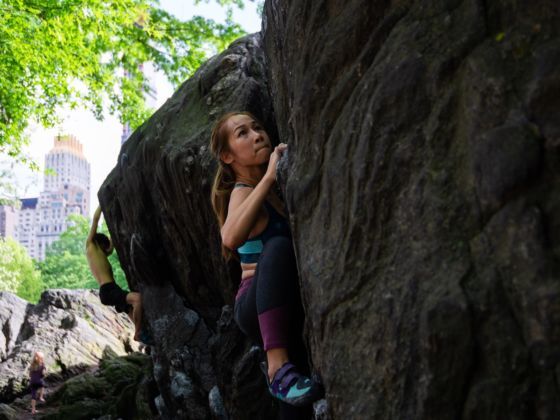THE APPEAL OF BOULDERING is clear: Relatively little equipment is needed, almost no technical knowledge is required, and access is usually simple. In addition to this, bouldering allows climbers to focus on specific techniques while challenging their physical strength and offering the opportunity for more dynamic styles of climbing.


Get the Gear
You don’t need a lot of equipment to start bouldering, but there are a few things that are necessary.
First, is a good pair of climbing specific shoes. While some people manage to climb long routes in the gym and even outdoors using sneakers, bouldering requires precise foot placements only possible with real climbing shoes.
Another thing that is absolutely necessary is a good bouldering pad, or “crash pad.” Crash pads have a thin layer of hard foam, usually 1 inch closed-cell, on the bottom, and a thicker layer of soft foam, usually 3-4 inches of open-cell, on top. The pad protects the landing below the boulder.
The only other necessity is a bag to hold some gymnastic chalk, which can either be loose or contained in a chalk ball.
Safety First: Learn How to Spot
When you are first starting to boulder, it’s not a good idea to climb alone. Find a friend and be diligent about spotting one another.
When spotting, find a solid stance, hold your hands out, and tuck your thumbs alongside your hand to prevent jams. Follow the climber with your eyes and body the whole time she is climbing.
Remember that the goal of spotting is not to catch a falling climber. Instead, try to direct them so that they fall on the crash pad feet first. Above all, help prevent them from falling on their neck or head.
Find A Problem
Because the climbs are shorter than “routes” and take some time to figure out, they are called “problems.” Just like rock climbing routes, boulder problems are graded based on their difficulty.
In America, a “V-scale” is used. V0 is the easiest, V1 slightly more difficult, and so on. In Europe, the French scale, which grades climbs by letter and number, is used.
As an example, a V2 in America is roughly the same as a 6a in Europe, a V3 as a 6a+, and a V4 as a 6b.
Difficulty ratings are a tricky thing in climbing. They will vary from place to place and even boulder to boulder.
Differences in ability, conditioning, and physique can make a boulder problem feel “easier” or “harder.”
The best advice is to start low and work your way up slowly. Only time and experience will allow you to climb a certain grade with confidence.
Get More Information
If you are looking to move beyond the basics, your local climbing gym is a great place to start. Every climbing gym now offers indoor bouldering and the staff and other climbers will be able to direct you to popular outdoor areas.
If you want to read more, check out Better Bouldering, written by one of the fathers of American bouldering, John Sherman.
Ultimately, the most appealing part of bouldering is its inherent freedom and the unique way it allows you to interact with the local environment. Untethered by a rope or gear, you are free to climb what you want, at your own pace. It is easy for climbers of dramatically different abilities to boulder along side each other, each finding his own challenges.
So, learn these basics, grab the gear, and get outside. The rocks are waiting.